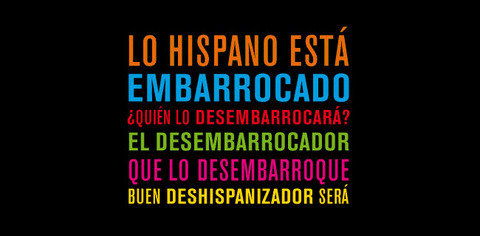The Baroque D_effect
dal 8/11/2010 al 26/2/2011
Segnalato da
8/11/2010
The Baroque D_effect
Centre de Cultura Contemporania de Barcelona CCCB, Barcelona
Politics of the Hispanic Image. The exhibition, curated by art historians Jorge Luis Marzo and Tere Badia, is a meticulous examination of the relation between the Hispanic myth and its principal survival strategy: the baroque. Of all the images used in Spanish-speaking countries to construct and legitimate their identity and memory, the baroque has been the most lasting, widespread and influential, often at the cost of other equally important threads. The show is devised as a dissection of this narrative and of the cultural policies that continue to write it today.

curated by art historians Jorge Luis Marzo and Tere Badia
The Hispanic phenomenon symbolizes the homogeneous framework shared by Spain and Latin America. But who built this myth and what strategies have been generated to keep it going down through the centuries, through many different regimes, ideologies and governments?
This exhibition, curated by art historians Jorge Luis Marzo and Tere Badia, is a meticulous examination of the relation between the Hispanic myth and its principal survival strategy: the baroque. Of all the images used in Spanish-speaking countries to construct and legitimate their identity and memory, the baroque has been the most lasting, widespread and influential, often at the cost of other equally important threads.
“The Baroque D_effect” is devised as a dissection of this narrative and of the cultural policies that continue to write it today. It should be seen then not as an exhibition of baroque art, but of the political and cultural strategies which over the years have helped to create an official homogenizing narrative, the Hispanic myth, and of the part played in it by the world of creation.
The show starts out from the expediency of examining these questions from the viewpoint of contemporary creation, one of the principal heirs to this myth-making narrative. Using cinema, videos, documentaries, animation and installations, the exhibition presents visitors with some alternatives in the debate on the relations between art and power in societies submerged in conflicts of historical memory.
The show is the product of six years of research in Spain, Mexico, Peru and Chile, countries of great cultural and socio-political diversity and complexity that have helped by their example to dilute the myth of Hispanic homogenization.
1. Painter to the King
In 1990, the Museum of El Prado presented a major exhibition of the painter Diego Velázquez as part of the preparations for the great events of 1992. The museum thereby prefigured one of the pillars of Spain’s promotion abroad: culture, as a guiding principle of the society and its history.
2. Still Life with Rotting Fruit
Installation by Canadian artist David Hoffos that reflects on the mechanisms that create the illusion and falseness of the modern image.
3. The brand name
This section looks at the mechanisms behind the construction of a brand image, in this case that of the “Latin American” and/or “Hispanic” stereotype.
4. The Summit
The central space in the exhibition showcases the great diversity of opinions found in Spain and Latin America surrounding themes such as education, Spanish diplomacy, the tourist market and the myths of religion, language and festival. This kaleidoscopic review of the cornerstones of representation of “what is Hispanic” and its collision with reality comprises 25 audiovisual pieces, including the film by German director Thomas Pfanne, Extraños Seres. El Poder de Pachamama.
6. The vein of the Hispanic phenomenon
The mine of La Valenciana, in the Mexican city of Guanajuato, was one of the world’s principal sources of gold and silver between the 16th and 18th centuries. Ramiro, a former miner, gives his version of the memory of the place.
7. The politics of the image
Using fictional and documentary works, this section illustrates the ventriloquistic relations between culture and power. It includes the short fiction film El premio [‘The Prize’] by David Blanco and a section comprising interviews with a wide variety of Latin American cultural agents.
8. Pedagogical Missions. Circulating Museum / Museum of the People
This section includes a series of works that formed part of the Museo del Pueblo, an initiative dating from 1931-1936 as part of the Pedagogical Missions programme. The idea behind this museum was to familiarize the people with the works of the great painters in the form of a travelling exhibition of a collection of copies made specially for this purpose.
9. Iconoclasms: F.X. Archive
This fragmented installation by Seville artist Pedro G. Romero looks at the relations between processes of iconoclasm and its connection with various forms of popular expression. It includes an excerpt from the documentary Rocío by Fernando Ruiz Vergara, made in 1980, which charts the stark deconstruction of a religious image.
10. El niño Pepita
This visual production directed by the Peruvian filmmaker Claudia Llosa analyses the function of the “magical” image in a context of media saturation.
11. Final
Mexico vs. Brazil is a video work by the Mexican artist Miguel Calderón, showing a football match between the Brazilian and Mexican national sides and ending in Mexico 17–Brazil 0. The work highlights the recourse to “manifest destiny” in the face of situations of failure.
The exhibition closes with images of the Euro 2008 final between Germany and Spain, and reactions in the press all over the country, a literary storm of patriotism and progress once the “curse” of the quarter-finals was a thing of the past.
Press Service of the CCCB
Mònica Muñoz – Irene Ruiz – Elisabet Vilalta
Montalegre, 5 – 08001 Barcelona 93 3064123/ 93 3064143 premsa@cccb.org
Opening 9 November 2010
Centre de Cultura Contemporania de Barcelona CCCB
calle Montalegre, 5 - Barcelona
Opening hours: From Tuesday to Sunday from 11a.m. to 8p.m.
Thusday 11 a.m. at 10 p.m.
Closed on non-holiday Mondays
The ticket desk closes half an hour before the Centre's closing time



